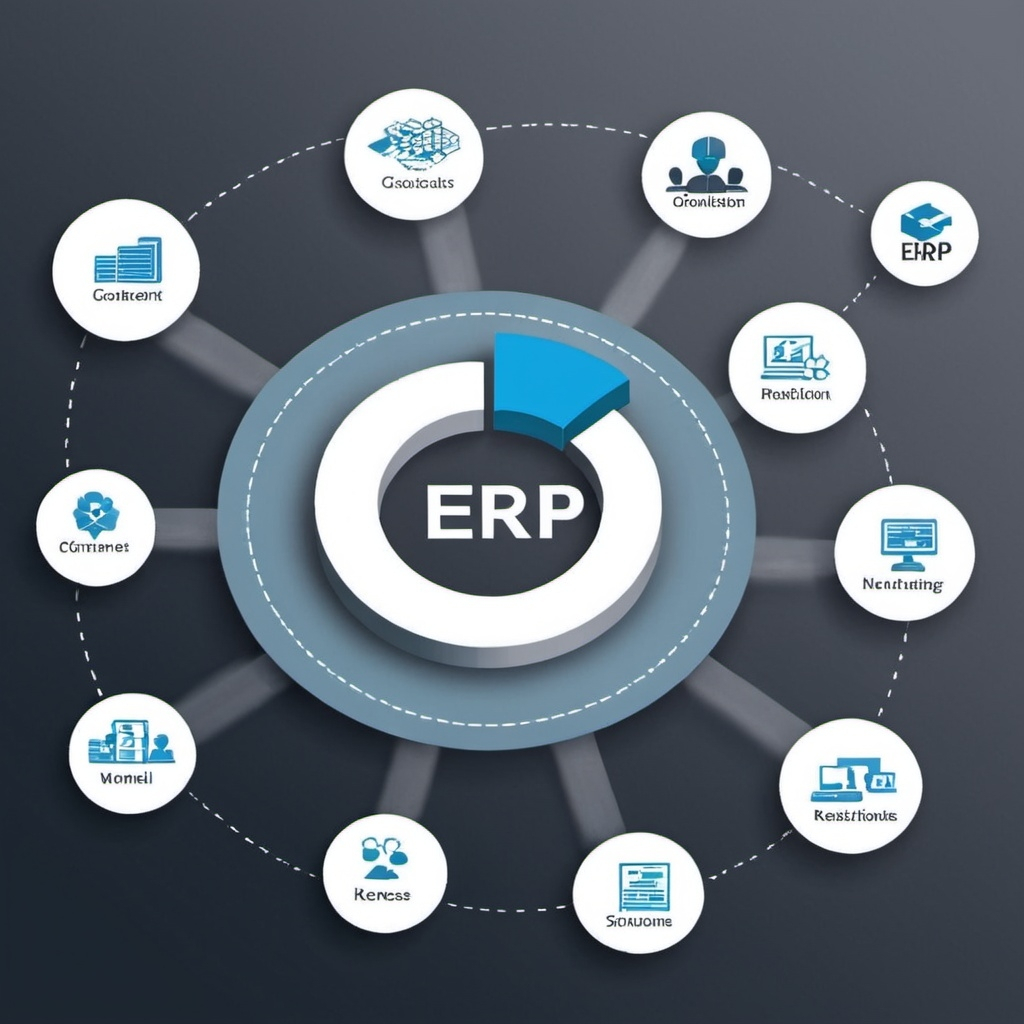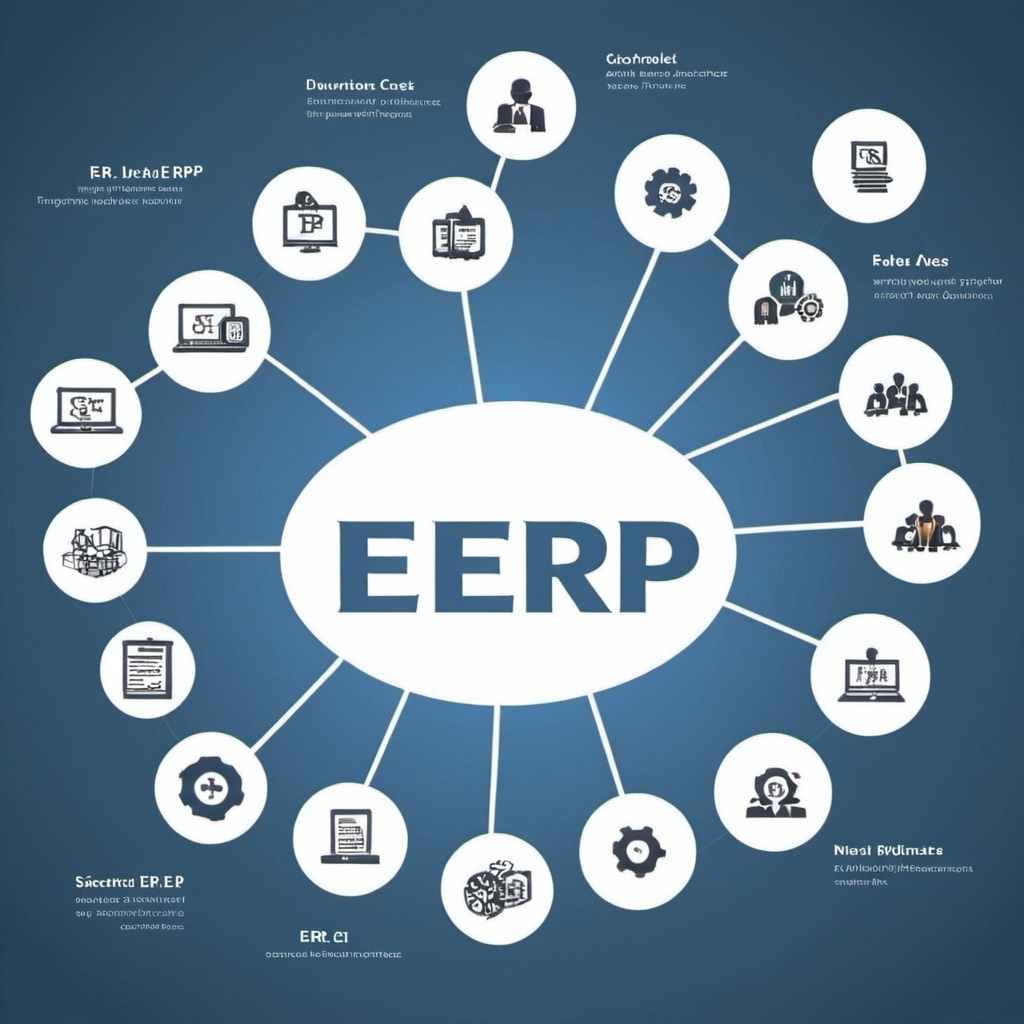Comprehensive Guide to Choosing the Best Language and Platform
ERPs have been in the marked since a few decades now. They were expensive back in the days but, today we have more options and some are even better than the legacy and proprietary ones. In the modern business landscape, efficiency and integration are paramount. Enterprises of all sizes seek solutions that streamline operations, enhance productivity, and provide a comprehensive overview of their activities. This is where Enterprise Resource Planning (ERP) software comes into play. ERP systems integrate various functions of a business—such as finance, human resources, manufacturing, and supply chain—into a unified system, providing a single source of truth and fostering better decision-making.
Choosing the right ERP software is a critical decision that can significantly impact a company’s efficiency and growth. One of the most crucial aspects of this decision is selecting the appropriate programming language and platform for developing or customizing the ERP system. The right choice can lead to a more robust, scalable, and user-friendly system, while a poor choice can result in inefficiencies and higher costs.
This article will delve into the intricacies of ERP software, exploring its components, benefits, and the best programming languages and platforms for developing such systems. We will also examine real-world examples, case studies, and provide practical advice for businesses looking to implement ERP solutions.
What is ERP Software?
ERP software is an integrated suite of applications designed to automate and manage core business processes. These processes typically include accounting, procurement, project management, risk management, compliance, and supply chain operations. ERP systems are designed to provide a unified and consistent data repository that various departments can access, ensuring that everyone in the organization works with the same information.
Key Components of ERP Software
- Financial Management: Manages accounting, budgeting, and financial reporting. This module ensures compliance with financial regulations and helps in making strategic financial decisions.
- Human Resource Management: Handles employee data, payroll, recruitment, and performance management. This module aids in optimizing workforce productivity and satisfaction.
- Supply Chain Management: Manages procurement, inventory, and logistics. This module ensures efficient supply chain operations and minimizes costs.
- Manufacturing: Oversees production planning, scheduling, and quality control. This module helps in maintaining production efficiency and product quality.
- Customer Relationship Management (CRM): Manages customer interactions, sales, and service. This module enhances customer satisfaction and loyalty.
- Project Management: Plans and monitors projects, including resource allocation and progress tracking. This module ensures timely and within-budget project completion.
- Data Analytics: Provides tools for data analysis, reporting, and business intelligence. This module helps in making informed and data-driven decisions.
Benefits of ERP Software
Implementing ERP software offers numerous benefits to organizations, including:
- Improved Efficiency: By automating repetitive tasks and integrating various business functions, ERP systems reduce manual labor and improve process efficiency.
- Enhanced Collaboration: ERP systems provide a centralized data repository, enabling better collaboration and communication across departments.
- Better Decision-Making: With real-time data and analytics, ERP systems provide insights that aid in strategic decision-making.
- Scalability: ERP systems can be scaled to accommodate business growth, ensuring that the system remains relevant as the organization expands.
- Regulatory Compliance: ERP systems help organizations adhere to regulatory requirements by maintaining accurate records and providing compliance tools.
- Cost Savings: By optimizing processes and reducing inefficiencies, ERP systems can lead to significant cost savings.
Choosing the Best Programming Language and Platform for ERP Software
Selecting the right programming language and platform is crucial for the successful implementation of ERP software. The choice depends on various factors, including the organization’s specific needs, the complexity of the ERP system, and the existing technology infrastructure. Here, we will explore some of the most popular programming languages and platforms for ERP development.
Popular Programming Languages for ERP Development
- Java
- Advantages: Java is a versatile and widely-used programming language known for its portability, scalability, and robustness. It has a vast ecosystem of libraries and frameworks, making it a popular choice for enterprise applications.
- Use Cases: Java is commonly used in large-scale ERP systems that require high performance and scalability. Examples include SAP and Oracle ERP systems.
- Frameworks: Spring, Hibernate
- Python
- Advantages: Python is known for its simplicity and readability, making it a favorite among developers. It has a rich set of libraries and is highly flexible.
- Use Cases: Python is suitable for ERP systems that require rapid development and ease of maintenance. It is also popular for integrating machine learning and data analytics capabilities.
- Frameworks: Django, Flask, Odoo
- C#
- Advantages: C# is a powerful language developed by Microsoft, known for its performance and integration capabilities with the .NET framework. It is well-suited for developing Windows-based applications.
- Use Cases: C# is often used in ERP systems that need to be closely integrated with other Microsoft products, such as Dynamics 365.
- Frameworks: .NET, ASP.NET
- JavaScript
- Advantages: JavaScript, along with its runtime environment Node.js, is excellent for developing cross-platform applications. It enables real-time data processing and is highly scalable.
- Use Cases: JavaScript is ideal for ERP systems that require dynamic user interfaces and seamless integration with web technologies.
- Frameworks: Node.js, Express.js, React.js
- PHP
- Advantages: PHP is a server-side scripting language known for its ease of use and widespread adoption in web development. It has a large community and numerous frameworks.
- Use Cases: PHP is suitable for ERP systems that are web-based and require rapid development cycles.
- Frameworks: Laravel, Symfony
Popular Platforms for ERP Development
- SAP
- Overview: SAP is one of the leading providers of ERP software, known for its comprehensive solutions that cater to various industries. SAP ERP systems are highly customizable and scalable.
- Language: ABAP (Advanced Business Application Programming), Java, and JavaScript
- Advantages: SAP offers extensive functionality, robust support, and a wide range of modules that cover all business processes.
- Oracle ERP Cloud
- Overview: Oracle ERP Cloud is a cloud-based ERP solution that offers a suite of applications for finance, procurement, project management, and more. It is designed for flexibility and scalability.
- Language: Java, SQL, PL/SQL
- Advantages: Oracle ERP Cloud provides comprehensive analytics, a modern user interface, and seamless integration with other Oracle products.
- Microsoft Dynamics 365
- Overview: Microsoft Dynamics 365 is a cloud-based ERP solution that integrates with other Microsoft products, such as Office 365 and Azure. It offers modules for finance, operations, sales, and customer service.
- Language: C#, JavaScript
Advantages: Microsoft Dynamics 365 provides a familiar user interface, robust integration capabilities, and strong support from Microsoft’s ecosystem.
- Odoo
- Overview: Odoo is an open-source ERP platform that offers a wide range of modules, including sales, CRM, project management, and inventory. It is highly customizable and suitable for small to medium-sized businesses.
- Language: Python, JavaScript
- Advantages: Odoo’s open-source nature allows for extensive customization and flexibility. It is cost-effective and has a large community of developers.
- NetSuite
- Overview: NetSuite is a cloud-based ERP solution by Oracle, designed for fast-growing businesses. It offers modules for financial management, CRM, e-commerce, and more.
- Language: JavaScript, SuiteScript
- Advantages: NetSuite provides real-time visibility into business operations, strong financial management capabilities, and scalability to support business growth.
Factors to Consider When Choosing a Language and Platform
When selecting a programming language and platform for ERP development, several factors should be considered to ensure the system meets the organization’s needs and can adapt to future changes.
Business Requirements
Understanding the specific business requirements is crucial. Different industries have unique needs, and the chosen ERP system must cater to these requirements. For instance, a manufacturing company may prioritize robust supply chain management and production planning features, while a service-based company may focus on CRM and project management.
Scalability
As the business grows, the ERP system should be able to scale accordingly. Choosing a language and platform that supports scalability ensures that the system remains effective as the organization expands.

Integration
ERP systems often need to integrate with other software applications, such as CRM, HR, and financial systems. Selecting a language and platform with strong integration capabilities can facilitate seamless data exchange and improve overall efficiency.
Customization
Every business has unique processes and workflows. An ERP system should be customizable to fit these specific needs. Open-source platforms like Odoo offer extensive customization options, while proprietary solutions like SAP and Oracle provide robust configuration capabilities.
User Experience
The usability of the ERP system is critical for user adoption. A system with an intuitive and user-friendly interface can enhance productivity and reduce training costs. Modern ERP solutions often emphasize a responsive design and accessibility across devices.
Cost
The cost of implementing and maintaining an ERP system can vary significantly based on the chosen language and platform. Open-source solutions like Odoo may offer lower upfront costs but could require more development effort. Proprietary solutions like SAP and Oracle might have higher initial costs but come with comprehensive support and built-in functionality.
Real-World Examples and Case Studies
To better understand the implications of choosing the right language and platform for ERP development, let’s explore some real-world examples and case studies.
SAP at Coca-Cola
Coca-Cola, one of the world’s leading beverage companies, uses SAP ERP to manage its global operations. SAP’s robust financial management, supply chain, and production planning modules help Coca-Cola streamline its processes and maintain high efficiency. The use of SAP’s ABAP language and integration capabilities ensures that Coca-Cola can customize its ERP system to meet specific business needs and integrate seamlessly with other applications.
Odoo at Toyota Material Handling
Toyota Material Handling, a leading manufacturer of material handling equipment, implemented Odoo to manage its operations. Odoo’s open-source nature allowed Toyota to customize the ERP system to fit its unique workflows and processes. The use of Python and JavaScript enabled rapid development and easy integration with other systems. This implementation resulted in improved efficiency, better inventory management, and enhanced customer service.

Microsoft Dynamics 365 at Metro Bank
Metro Bank, a UK-based retail bank, chose Microsoft Dynamics 365 for its ERP needs. The integration with other Microsoft products, such as Office 365 and Azure, provided a seamless experience for employees. The use of C# and JavaScript allowed for customization and development of additional functionalities tailored to the bank’s requirements. This implementation improved operational efficiency, customer service, and regulatory compliance.
Practical Advice for Implementing ERP Solutions
Implementing an ERP system is a complex process that requires careful planning and execution. Here are some practical tips to ensure a successful implementation:
- Define Clear Objectives: Clearly define the objectives and goals of the ERP implementation. Understand what you aim to achieve, whether it’s improved efficiency, better data visibility, or enhanced customer service.
- Choose the Right Team: Assemble a team of experienced professionals who understand both the technical and business aspects of the ERP system. This team should include project managers, developers, business analysts, and end-users.
- Conduct Thorough Research: Research different ERP solutions, programming languages, and platforms. Consider the specific needs of your organization and evaluate how well each option meets these needs.
- Plan for Customization: Identify areas where customization is required and plan for it accordingly. Ensure that the chosen language and platform support the necessary level of customization.
- Focus on Data Migration: Data migration is a critical aspect of ERP implementation. Ensure that data is accurately transferred from existing systems to the new ERP system. Clean and validate data to prevent issues post-implementation.
- Train Employees: Provide comprehensive training for employees to ensure they are comfortable using the new ERP system. Focus on both the technical aspects and how the system will improve their daily tasks.
- Monitor and Evaluate: Continuously monitor the ERP system post-implementation to identify any issues or areas for improvement. Regularly evaluate the system’s performance against the defined objectives and make necessary adjustments.
Future Trends in ERP Software
The ERP landscape is continuously evolving, with new trends and technologies shaping the future of these systems. Understanding these trends can help organizations stay ahead and leverage the latest innovations.
Artificial Intelligence and Machine Learning
AI and ML are becoming integral parts of ERP systems, providing advanced analytics, predictive capabilities, and automation. These technologies can help organizations identify patterns, make data-driven decisions, and automate routine tasks, leading to increased efficiency and reduced costs.
Cloud-Based ERP
Cloud-based ERP solutions are gaining popularity due to their scalability, flexibility, and lower upfront costs. These solutions allow organizations to access their ERP system from anywhere, ensuring continuity and collaboration. Cloud-based ERPs also offer regular updates and maintenance, reducing the burden on internal IT teams.
Internet of Things (IoT)
IoT integration with ERP systems can provide real-time data from connected devices, enhancing supply chain management, production planning, and asset management. This integration enables organizations to monitor and manage operations more effectively, leading to improved efficiency and reduced downtime.
Mobile ERP
Mobile ERP solutions allow employees to access the ERP system from their smartphones and tablets, improving flexibility and productivity. Mobile ERP applications provide real-time data and functionality on the go, enabling better decision-making and faster response times.
Enhanced User Experience
Modern ERP systems are focusing on providing an enhanced user experience with intuitive interfaces, personalized dashboards, and responsive designs. These improvements aim to increase user adoption, reduce training costs, and improve overall satisfaction.
Cost-Effective ERP Options for Small and Mid-Sized Organizations
For small and mid-sized organizations, finding an affordable ERP solution that meets their needs can be challenging. However, several cost-effective ERP systems offer robust functionality without breaking the bank. Here, we’ll explore some of the best options available.

1. Odoo
Overview
Odoo is a comprehensive open-source ERP solution that provides a wide range of applications, including CRM, sales, inventory management, accounting, and more. Its modular design allows businesses to start with the essentials and expand as needed.
Key Features
- Modular Structure: Choose and implement only the modules needed.
- Customization: Highly customizable to fit specific business processes.
- Integration: Seamlessly integrates with other applications and services.
- Community Support: A large community of developers and users offers support and resources.
Cost
Odoo offers a free version with basic features and paid versions starting at $20 per user per month, with additional costs for advanced modules and services.
2. Zoho ERP
Overview
Zoho ERP, part of the Zoho One suite, is a cloud-based solution designed for small and mid-sized businesses. It offers a wide range of applications, from CRM and project management to finance and inventory.
Key Features
- Cloud-Based: Accessible from anywhere with an internet connection.
- Integrated Suite: Includes over 40 applications for various business functions.
- User-Friendly Interface: Intuitive and easy to use.
- Scalability: Scales with business growth, adding more users and applications as needed.
Cost
Zoho ERP is part of Zoho One, which costs $30 per user per month when billed annually. This includes access to the entire suite of Zoho applications.
3. ERPNext
Overview
ERPNext is an open-source ERP solution that provides comprehensive features for managing all aspects of a business. It is suitable for manufacturing, distribution, retail, education, and other sectors.
Key Features
- Full-Featured: Includes modules for accounting, inventory, CRM, sales, purchasing, and more.
- Customization: Open-source nature allows for extensive customization.
- Cloud and On-Premises: Available as a cloud-hosted service or can be self-hosted.
- Community Support: Strong community support with regular updates and enhancements.
Cost
ERPNext offers a free self-hosted version. Cloud-hosted plans start at $50 per month for five users, with additional costs for extra users and storage.
4. Microsoft Dynamics 365 Business Central
Overview
Microsoft Dynamics 365 Business Central is a cloud-based ERP solution designed for small and mid-sized businesses. It integrates with other Microsoft products, providing a seamless experience for users familiar with the Microsoft ecosystem.
Key Features
- Integration: Deep integration with Office 365 and other Microsoft products.
- Scalability: Easily scales as the business grows.
- Comprehensive Modules: Includes modules for finance, sales, service, project management, and more.
- User-Friendly: Intuitive interface that is easy to navigate.
Cost
Business Central pricing starts at $70 per user per month for the Essentials plan and $100 per user per month for the Premium plan.
5. Sage 100cloud
Overview
Sage 100cloud is a popular ERP solution for small to mid-sized businesses, offering robust functionality across various business areas. It is particularly strong in accounting and finance but also includes modules for inventory, distribution, and manufacturing.
Key Features
- Strong Accounting Features: Comprehensive accounting and financial management tools.
- Customization: Highly customizable to meet specific business needs.
- Scalability: Suitable for growing businesses with expanding needs.
- Integration: Integrates with other Sage products and third-party applications.
Cost
Sage 100cloud pricing is typically quote-based, but it is known for being cost-effective for smaller businesses. Pricing usually starts around $45 per user per month.
6. Acumatica
Overview
Acumatica is a cloud-based ERP solution that offers a comprehensive suite of applications tailored for small and mid-sized businesses. It provides flexibility, ease of use, and powerful features.
Key Features
- True Cloud ERP: Built for the cloud, offering anytime, anywhere access.
- Flexible Licensing: Flexible licensing options based on resource usage rather than per-user fees.
- Full-Featured: Includes modules for financial management, CRM, project accounting, and more.
- User-Friendly: Intuitive interface and robust reporting tools.
Cost
Acumatica offers flexible pricing based on the resources used rather than the number of users, making it cost-effective for businesses with many users. Specific pricing details are provided through custom quotes.
Conclusion
Choosing the right programming language and platform for ERP development is a critical decision that can significantly impact the success of the ERP implementation. By understanding the specific needs of the organization and evaluating the available options, businesses can select a solution that offers scalability, integration, customization, and a positive user experience.

Small and mid-sized organizations have several cost-effective ERP options to choose from, each offering a unique set of features and benefits. By evaluating the specific needs of the business, the available budget, and the desired functionality, businesses can select an ERP solution that provides maximum value without compromising on quality or performance. Whether opting for an open-source solution like Odoo or ERPNext, a cloud-based system like Zoho ERP or Acumatica, or a well-integrated platform like Microsoft Dynamics 365 Business Central, the key is to choose a solution that aligns with the organization’s goals and growth trajectory.
Whether opting for a well-established platform like SAP or Oracle, or choosing an open-source solution like Odoo, the key is to ensure that the ERP system aligns with the organization’s goals and can adapt to future changes. With the right approach, businesses can leverage ERP software to streamline operations, enhance productivity, and drive growth.
Curated Read





Great insights! I found your take on sustainable living incredibly practical. Looking forward to implementing some of these tips! Check out [Get Info](https://getinfo.ink) for more inspiring content.